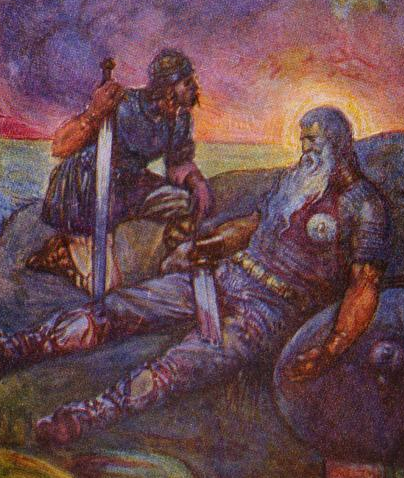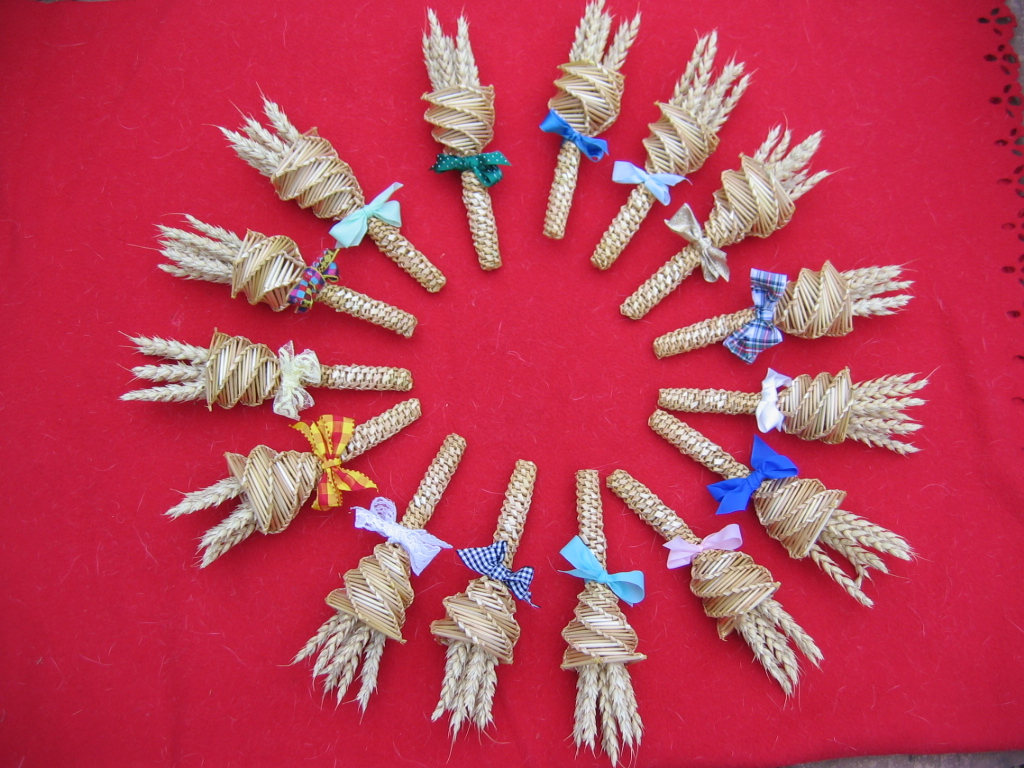|
Bēow
Beowa, Beaw, Bēow , Beo or Bedwig is a figure in Anglo-Saxon traditional religion associated with barley and agriculture. The figure is attested in the Anglo-Saxon royal genealogies as they were extended in the age of Alfred, where Beowa is inserted as the son of Scyld and the grandson of Sceafa, in lineages carried back to Adam. Connections have been proposed between the figure of Beowa and the hero Beowulf of the poem of the same name and English folk song figure John Barleycorn. Etymology ''Beoƿ'' is an Old English word for barley. In the Anglo-Saxon genealogies, Beoƿa is the son or grandson of Sceafa, the Old English word for sheaf. The noun ''beoƿ'' has an Old Norse parallel in ''Bygg'', the word for "grain." Related comparisons have been made between the figure of Beoƿ and Byggvir, attested in the ''Prose Edda'' as a servant of the god Freyr.Alexander (2002:28). Theories Some scholars posit a connection between the mythical figure of Beowa and the legendary Beowulf. ... [...More Info...] [...Related Items...] OR: [Wikipedia] [Google] [Baidu] |
Beowulf (hero)
Beowulf (; ) is a legendary Geatish hero in the eponymous epic poem, one of the oldest surviving pieces of English literature. Etymology and origins of the character A number of origins have been proposed for the name ''Beowulf''. Beowulf Henry Sweet, a philologist and linguist specializing in Germanic languages, proposed that the name ''Bēowulf'' literally means in Old English "bee-wolf" or "bee-hunter" and that it is a kenning for "bear".Sweet, Henry. (1884) ''Anglo-Saxon Reader in Prose and Verse'' The Clarendon Press, p. 202. Recorded instances of similar names mirror this etymology. The 1031 AD ''Liber Vitae'' records the name ''Biuuuwulf''. The name is attested to a monk from Durham and means ''bee wolf'' in the Old Northumbrian dialect.Chadwick, Hector Munro (1983) ''The Origin of the English Nation'', p. 294. The 11th century English ''Domesday Book'' contains a recorded instance of the name ''Beulf''. The scholar suggested that the name ''Beowulf'' derived from a ... [...More Info...] [...Related Items...] OR: [Wikipedia] [Google] [Baidu] |
Beowulf
''Beowulf'' (; ) is an Old English poetry, Old English poem, an Epic poetry, epic in the tradition of Germanic heroic legend consisting of 3,182 Alliterative verse, alliterative lines. It is one of the most important and List of translations of Beowulf, most often translated works of Old English literature. The date of composition is a matter of contention among scholars; the only certain dating is for the manuscript, which was produced between 975 and 1025 AD. Scholars call the anonymous author the "''Beowulf'' poet". The story is set in pagan Scandinavia in the 5th and 6th centuries. Beowulf (hero), Beowulf, a hero of the Geats, comes to the aid of Hrothgar, the king of the Danes (Germanic tribe), Danes, whose mead hall Heorot has been under attack by the monster Grendel for twelve years. After Beowulf slays him, Grendel's mother takes revenge and is in turn defeated. Victorious, Beowulf goes home to Geatland and becomes king of the Geats. Fifty years later, Beowulf def ... [...More Info...] [...Related Items...] OR: [Wikipedia] [Google] [Baidu] |
Anglo-Saxon Royal Genealogies
A number of royal genealogies of the Anglo-Saxon kingdoms, collectively referred to as the Anglo-Saxon royal genealogies, have been preserved in a manuscript tradition based in the 8th to 10th centuries. The genealogies trace the succession of the early Anglo-Saxon kings, back to the semi-legendary kings of the Anglo-Saxon settlement of Britain, notably named as Hengist and Horsa in Bede's ''Historia ecclesiastica gentis Anglorum'', and further to legendary kings and heroes of the pre-migration period, usually including an eponymous ancestor of the respective lineage and converging on Woden. In their fully elaborated forms as preserved in the '' Anglo-Saxon Chronicles'' and the ''Textus Roffensis'', they continue the pedigrees back to the biblical patriarchs Noah and Adam. They also served as the basis for pedigrees that would be developed in 13th century Iceland for the Scandinavian royalty. Documentary tradition The Anglo-Saxons, uniquely among the early Germanic peoples, pre ... [...More Info...] [...Related Items...] OR: [Wikipedia] [Google] [Baidu] |
Byggvir
Byggvir is a figure in Norse mythology. The only surviving mention of Byggvir appears in the prose beginning of '' Lokasenna'', and stanzas 55 through 56 of the same poem, where he is referred to as one of Freyr's servants and as the husband of Beyla. ''Bygg'' is the Old Norse Old Norse, also referred to as Old Nordic or Old Scandinavian, was a stage of development of North Germanic languages, North Germanic dialects before their final divergence into separate Nordic languages. Old Norse was spoken by inhabitants ... word for barley. Subsequently, Byggvir is often identified with this etymology of his name and connections have been placed with the mentioning of Byggvir's described involvement with mill-grinding as being potential references to barley processing.Lindow (2001:90-91) Comparisons to the Anglo-Saxon figure of Beowa ( Old English "barley") have been put forth.Bruce (2002:28). ''Lokasenna'' In ''Lokasenna'', Loki is depicted as degrading Byggvir for being ... [...More Info...] [...Related Items...] OR: [Wikipedia] [Google] [Baidu] |
Routledge
Routledge ( ) is a British multinational corporation, multinational publisher. It was founded in 1836 by George Routledge, and specialises in providing academic books, academic journals, journals and online resources in the fields of the humanities, behavioral science, behavioural science, education, law, and social science. The company publishes approximately 1,800 journals and 5,000 new books each year and their backlist encompasses over 140,000 titles. Routledge is claimed to be the largest global academic publisher within humanities and social sciences. In 1998, Routledge became a subdivision and Imprint (trade name), imprint of its former rival, Taylor & Francis, Taylor & Francis Group (T&F), as a result of a £90-million acquisition deal from Cinven, a venture capital group which had purchased it two years previously for £25 million. Following the merger of Informa and T&F in 2004, Routledge became a publishing unit and major imprint within the Informa "academic publishing ... [...More Info...] [...Related Items...] OR: [Wikipedia] [Google] [Baidu] |
Corn Dolly
Corn dollies or corn mothers are a form of straw work made as part of harvest customs of Europe before mechanisation. Scholars of the 18th and 19th centuries theorized that before Christianisation, in traditional pagan European culture it was believed that the spirit of the corn (in American English, "corn" would be "grain") lived amongst the crop, and that the harvest made it effectively homeless. James Frazer devotes chapters in ''The Golden Bough'' to "Corn-Mother and Corn-Maiden in Northern Europe" (chs. 45–48) and adduces European folkloric examples collected in great abundance by the folklorist Wilhelm Mannhardt. Among the customs attached to the last sheaf of the harvest were hollow shapes fashioned from the last sheaf of wheat or other cereal crops. The corn spirit would then spend the winter in this home until the "corn dolly" was ploughed into the first furrow of the new season. Background James George Frazer discusses the Corn-mother and the Corn-maiden in Norther ... [...More Info...] [...Related Items...] OR: [Wikipedia] [Google] [Baidu] |
Beyla
Beyla (Old Norse: ) is one of Freyr's servants along with her husband, Byggvir, in Norse mythology. Beyla is mentioned in stanzas 55, 66, and the prose introduction to the Poetic Edda poem ''Lokasenna''. Since this is the only mention of Beyla, scholars have turned to the etymology of Beyla's name for additional information about her. However, the meaning of her name is unclear and her name has been proposed as related to "cow," "bean," or "bee." ''Lokasenna'' In the prose introduction to ''Lokasenna'', Beyla and Byggvir are cited as attending In stanza 55 of ''Lokasenna'', after his verses with Sif, Loki accuses Beyla of being filthy but the reason for this is unclear.Lindow (2001:78). Stanza 55: Stanza 56: In relation to Loki's comments in ''Lokasenna'', proposals have been made that Beyla and her husband are personifications of agriculture associated with Freyr: Beyla as the manure that softens the earth and develops the seed, Byggvir as the refuse of the mill, chaff.T ... [...More Info...] [...Related Items...] OR: [Wikipedia] [Google] [Baidu] |
Bödvar Bjarki
Bödvar Bjarki ( ), meaning 'Warlike Little-Bear', is the hero appearing in tales of Hrólfr Kraki in the '' Hrólfs saga kraka'', in the Latin epitome to the lost '' Skjöldunga saga'', and as ''Biarco'' in Saxo Grammaticus' . He is often depicted with the ability to shapeshift into a bear. Legend Bjarki's father, Björn (which means "bear"), was the son of Hring, a King in Norway. After Björn's mother died, Hring married a much younger Sámi woman called Hvit. Björn became a tall, strong young man, and he and a young woman named Bera were in love. At a time when Hring was away, Hvit tried to seduce Björn, but he rejected her. She cast a spell that made him a bear by day and a man only by night. He fled to the area near Bera's father's farm, where he lived by killing livestock, and he brought Bera to live with him. Urged by Hvit, the king took his hunters to kill the bear. Björn foresaw his death and told Bera that she was pregnant, telling her what to do after his death. ... [...More Info...] [...Related Items...] OR: [Wikipedia] [Google] [Baidu] |
Bjarkarímur
''Bjarkarímur'' is a 15th-century Icelandic ''rímur'' cycle on the Skjöldungs (the Scyldings of ''Beowulf''), and retells among other things the adventures of Hróarr (Hroðgar) and his brother Helgi (Halga), and those of Böðvarr Bjarki. It appears to be based on the lost ''Skjöldunga saga'' and is one of the extant sources of information on that work. References * Jónas Kristjánsson, Eddas and Sagas: ''Iceland's Medieval Literature'', trans. by Peter Foote Peter Godfrey Foote (26 May 1924 – 29 September 2009) was a scholar of Old Norse literature and Scandinavian studies. He inaugurated the Department of Scandinavian Studies at University College London, and headed it for 20 years. Early life a ... (Reykjavík: Hið Íslenska bókmenntafélag: 1988), p. 353. Old Norse poetry Rímur {{poem-stub ... [...More Info...] [...Related Items...] OR: [Wikipedia] [Google] [Baidu] |
Kálfsvísa
The ''Kálfsvísa'' ("Kálfr's '' vísa''", Kálfr being maybe the name of its author) is a poem partially preserved in Snorri Sturluson’s ''Skáldskaparmál''. Its three stanzas in ''fornyrðislag Old Norse poetry encompasses a range of verse forms written in the Old Norse language, during the period from the 8th century to as late as the far end of the 13th century. Old Norse poetry is associated with the area now referred to as Scandinav ...'' mostly consist of a þula of horses and their riders, Germanic heroes (for instance Grani and Sigurðr). The ''Kálfsvísa'' also includes a narrative dealing with the Battle on the Ice of Lake Vänern between Áli and Aðils.This battle is also referred to in the ''Skáldskaparmál'' (44), in the ''Ynglinga saga'' (29), in the ''Skjöldunga saga'' and in ''Beowulf'' (2391-2396). Notes External links The ''Kálfsvísa'' in the original language. {{DEFAULTSORT:Kalfsvisa Skaldic poems ... [...More Info...] [...Related Items...] OR: [Wikipedia] [Google] [Baidu] |



